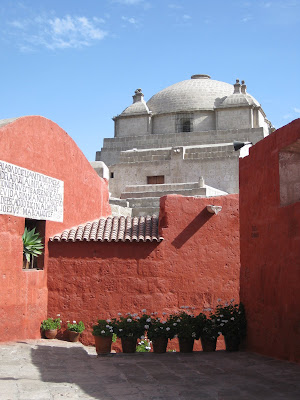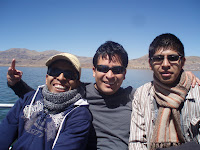
Saturday, October 31
Raw fish and alpaca steaks!

Thursday, October 29
I know I'm supposed to write about Peru
Tuesday, October 27
He's makes $10 a day...
Saturday, October 24
Peru close to decriminalizing abortion
Friday, October 23
Economic crisis? Not in Peru.
Thursday, October 22
Remember that stolen lung?
Wednesday, October 21
How do you say "rebound" in Spanish?
Tuesday, October 20
Climate change means jungle diseases don't stay there
63 days without rain
Monday, October 19
The floating city


Sunday, October 18
The soda that beat out Coca Cola

Having tried it, I'd say that description is close to accurate. Inca Kola! It sure is satisfying, especially after a salty plate of chicharrones.
But the story of Inca Kola, and how it came to dominate the Peruvian soda market, is even more satisfying if you're the type who likes to "stick to the man."
In 1935, a beverage maker in Lima brewed up a new concoction to commemorate 400 years since the city's founding. Using the herb "lemon verbena," they created a soft drink that appealed to Peruvian pride in it's heritage.
Within a few years, Inca Kola was the most popular in Peru. But Coca Cola and Pepsi, then competing to dominate the world soda markets, wanted to change that.
JournalPeru, an online magazine on Peru, explains well what happened:
For years, Coca-Cola and its arch-rival Pepsi tried to dominate the Peruvian market, but despite their vast resources, they were never able to overtake Inca Kola as the preferred soft drink of the Peruvian public.
Inca Kola cleverly marketed itself as the nationalistic soft drink option, and Peruvians drank it by the gallons. Knowing the Peruvian market, Inca Kola targeted small mom-and-pop shops and restaurants, offering incentives and marketing assistence. Partly due to national pride, partly due to its sweet flavor, and partly due to its cost (less than its rivals) Inca Kola became the leader of the Peruvian soft drink industry. One of its key marketing strategies was to convince Peruvians that Inca Kola was a much better complement to Peruvian food than either Coke or Pepsi.
As for the future of the company, it's won my heart and my taste buds. I'm going to be looking for Incan gold in my Colorado supermarket when I return.
Saturday, October 17
UN: Peru reduces extreme poverty by half?
A Peruvian family





Friday, October 16
If I could make a soundtrack...
Thursday, October 15
A hunt for rebels in the jungles of Peru
Wednesday, October 14
Terrorism has returned to Peru?
Tuesday, October 13
Miss Independent?
Nicolasa and Daisy

Friday, October 9
Etymology and idiots
Thursday, October 8
Nine!
Wednesday, October 7
The Giant Bear-Like Dog is now a mama!
He stole a lung!
Tuesday, October 6
Protests in Arequipa close down the national highway
 Protests here in Arequipa stalled traffic on the Panamericana del Sur, the national and international highway that starts in Alaska and ends in Buenos Aires.
Protests here in Arequipa stalled traffic on the Panamericana del Sur, the national and international highway that starts in Alaska and ends in Buenos Aires. 
Monday, October 5
She was buried under ice on the top of a volcano...

And I thought I had culture shock
Sunday, October 4
The city within the city


Sundays: Adobo de Chancho

Adobo de Chancho (Pork Marinade)
2 lbs of pork sirloin, cubed
3 cloves of garlic, chopped
3/4 cup of dark beer, chica de jora or vinegar
1/4 cup of chili powder
1 tsp of paprika
1 tsp of oregano
1 tsp of cumin powder
2 bay leaves
salt & pepper to taste
Adobo:
1 small red onion, chopped
2 cloves of garlic, chopped
1 large peeled & seeded tomato, chopped finely
1/2 cup of fresh green peas
salt & pepper to taste
Mix the pork with all the ingredients for the marinade in a large bowl and leave refrigerated overnight. Remove meat and reserve marinade liquid.Coat Dutch oven with cooking spray over medium-high heat and brown the meat in batches until done. Remove and keep warm. Add onion and cook until soft, 5-7 minutes. Add garlic and cook until fragrant, about 1 minute. Add tomato and half the marinade liquid and stir. When hot add the pork and cover tightly cook about 30 minutes. Add peas and continue cooking until meat and vegetables are tender, about 15 minutes more. Serve with rice and sweet potatoes. Serves 8.
Friday, October 2
Today, all South Americans are Brazilian!
Peru's President Alan Garcia told media that Peru feels the victory as its own, that it represents a victory for all Latin America, and that it represents an opportunity for Peru's tourist industry."Even though I will not be in power, I will work hard so that all the citizens of the world who go to Brazil will make a stop in Peru, on the way there and the way back," he said.
Ode to Traveler's Diarrhea
4 lbs. chicken
1/2 cup of oil
1/2 lb. of chopped nuts
2 tsp ground garlic
6 chilis liquidized (the closest thing to aji in the U.S.)
4 slices of bread
1 large tin of evaporated milk
1 large onion , finely chopped
salt & pepper to taste
6 yellow potatoes ( normal potatoes are fine)
olives, hard boiled eggs
Decorate the dish with halved potatoes and eggs quartered lengthwise and olives. Serve with the boiled rice.















.jpg)